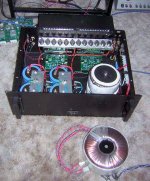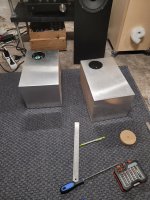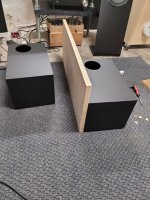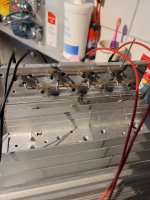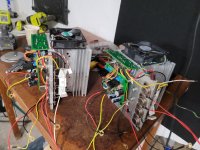I see that Kimber Kable 4TC.. Good stuff!I just found the gerbers for both KSA50 boards. But I don't really recommend using the old one. Just the Pinkmouse board as it is much easier to mount. Not going to post it as someone else already did.
Here are is an image I found of the very first KSA50 I built using the original boards. This image IS DATED March 20, 2005. I will post more of my final build of the KSA50 as I find them.
There is a place in Salt Lake City that I could walk in and buy it by the meter. I also used it twisted three strands in my Pass Aleph P balanced line stage...I see that Kimber Kable 4TC.. Good stuff!
Thanks, this is single-sided PCB, suitable for etching at home by toner transfer method. Where are the files for the PCBs posted in this thread?I just found the gerbers for both KSA50 boards. But I don't really recommend using the old one. Just the Pinkmouse board as it is much easier to mount. Not going to post it as someone else already did.
Here are is an image I found of the very first KSA50 I built using the original boards. This image IS DATED March 20, 2005. I will post more of my final build of the KSA50 as I find them.
Sumesh
The gerbers are a few posts above mine. Good luck with the single sided board. Be sure to use a blank that has 2 ounce copper on it. Currents are much higher that your average class ab amplifier and the standard 1 ounce boards may not hold up.
There is a place in Salt Lake City that I could walk in and buy it by the meter. I also used it twisted three strands in my Pass Aleph P balanced line stage...
Hello Mark - that place was called RAELCO. I lived in SLC from 2002 to 2009 and hung out there! Robert and the other guys were just awesome! Tubes, transistors, heatsinks, caps, resistors, they sold EVERYTHING!
I continued going there when in SLC to ski, but sadly, about four years ago it burned down...
Yes, I knew Robert for 25 years, but he didn't sell the Mogami stuff. That was Performance Audio on Main St. The wire I did get from Robert among hundreds of other things was the 12 and 14 gauge mil spec Teflon stuff he used to sell. RAELCO burned down a couple months before I moved to Tennessee. There was also Salt Lake Instrument on 3300 south. Bill had over a million tubes of all kinds. I actually found a set of Farnsworth Image Dissectors on the top of one of his shelving units. He only charged me $250 apiece. I still have one and the other is on display at the Henry Ford Museum in Detroit. I took pictures in both those places. Will try to post a few later...Hello Mark - that place was called RAELCO. I lived in SLC from 2002 to 2009 and hung out there! Robert and the other guys were just awesome! Tubes, transistors, heatsinks, caps, resistors, they sold EVERYTHING!
I continued going there when in SLC to ski, but sadly, about four years ago it burned down...
By the way, Im pretty sure Robert went to work for Standard Electric Supply about 3 blocks south of where RAELCO was at. I lived in SLC for 25 years...
This was my version of the KSA50 MK2 that I ran for a good 10 years at home, driving a pair of Dynaudios. The amp was driven from a Pass Aleph P line stage.
I had a bad AB systems six channel amplifier that I stripped out. Although it doesn't look like much heat sinking for a Class A power amp the heatsinks worked really well and there were two 4 inch fans running at half speed under that rear cover over the sinks. The amp actually never over heated or ran hot. It only ever ran warm when biased correctly. The two 400VA toroids were replaced by a 1200 VA dual secondary surplus toroid. This definitely gave the amplifier a bit more kick than the two smaller toroids offered.
My current system is drastically different. A pair of KEF LS50's on stands, driven by an ARCAM integrated amp as line stage and feeding a Mini Aleph. It's signal sourced from a Raspberry Pi based NAS and JRiver on my computer for playback. The SPDIF out on the computer motherboard feeds my home made transformer output DAC and into the ARCAM. I ripped all 400+ of my own CD's, and many from all the nearby libraries, plus many I bought at estate sales. I got out of vinyl in 2002!!
I had a bad AB systems six channel amplifier that I stripped out. Although it doesn't look like much heat sinking for a Class A power amp the heatsinks worked really well and there were two 4 inch fans running at half speed under that rear cover over the sinks. The amp actually never over heated or ran hot. It only ever ran warm when biased correctly. The two 400VA toroids were replaced by a 1200 VA dual secondary surplus toroid. This definitely gave the amplifier a bit more kick than the two smaller toroids offered.
My current system is drastically different. A pair of KEF LS50's on stands, driven by an ARCAM integrated amp as line stage and feeding a Mini Aleph. It's signal sourced from a Raspberry Pi based NAS and JRiver on my computer for playback. The SPDIF out on the computer motherboard feeds my home made transformer output DAC and into the ARCAM. I ripped all 400+ of my own CD's, and many from all the nearby libraries, plus many I bought at estate sales. I got out of vinyl in 2002!!
Attachments
No, they are both double sided boards. There is no need to reinvent the wheel as the Chinese tried to do with these boards. Their board is obviously unstable as a couple friends I know have tried to use them and ended up with disastrous results. It's easy getting samples of circuit boards made these days. Almost all circuit board houses offer the service.Thanks, this is single-sided PCB, suitable for etching at home by toner transfer method. Where are the files for the PCBs posted in this thread?
Sumesh
OK. Noted.No, they are both double sided boards. There is no need to reinvent the wheel as the Chinese tried to do with these boards. Their board is obviously unstable as a couple friends I know have tried to use them and ended up with disastrous results. It's easy getting samples of circuit boards made these days. Almost all circuit board houses offer the service.
Thank you!
Ohoj everyone!
My friend found his old clone in the garage, forgotten and dirty. He gave it to me and I started to convert it to monoblocks. I am almost ready to fire them up and the nerves are starting to act up.
The amp was assembled using Pinkmouses boards and the parts from the group buy. It was tried running +-42VDC rails with a pair of MJ15003/MJ15004 per channel.
The only thing changed is that I replaced the massive 1kW 2x30V transformer with a pair of 200W 2x18V transformers for the mono configuration.
This will of course give me less power but that isn't a problem.
Now, I haven't changed any settings when it comes to the bias since its initial startup so I was hoping to get a few questions answered before I flip the switch.
I don't have a bench supply or a variac.
1. Should I lower the bias before starting the amp with the different power supply? If so, clockwise or counterclockwise? Or is it just to switch on and adjust?
2. I got the tip that around 1,3A should give me around 25W but what does that translate to in mV across each of the emitter resistors?
3. Do I need to desolder and change any parts on the boards?
I am really looking forward to get this thing working 🙂
My friend found his old clone in the garage, forgotten and dirty. He gave it to me and I started to convert it to monoblocks. I am almost ready to fire them up and the nerves are starting to act up.
The amp was assembled using Pinkmouses boards and the parts from the group buy. It was tried running +-42VDC rails with a pair of MJ15003/MJ15004 per channel.
The only thing changed is that I replaced the massive 1kW 2x30V transformer with a pair of 200W 2x18V transformers for the mono configuration.
This will of course give me less power but that isn't a problem.
Now, I haven't changed any settings when it comes to the bias since its initial startup so I was hoping to get a few questions answered before I flip the switch.
I don't have a bench supply or a variac.
1. Should I lower the bias before starting the amp with the different power supply? If so, clockwise or counterclockwise? Or is it just to switch on and adjust?
2. I got the tip that around 1,3A should give me around 25W but what does that translate to in mV across each of the emitter resistors?
3. Do I need to desolder and change any parts on the boards?
I am really looking forward to get this thing working 🙂
Is it possible to first power up with a low AB bias (even though it is a KSA) using a dim bulb tester? Those are low cost and easy to build. Then test it out with a low bias? When satisfied that everything is right remove the dim bulb tester (DBT) and bias higher as per normal KSA?
I did not use Pinkmouse boards so this is just a suggestion to consider.
I did not use Pinkmouse boards so this is just a suggestion to consider.
I really feel as though one pair of output devices is not enough. You also need to beg, borrow, or steal a variac. One flip of the power switch could destroy your work. And yes, turn the bias all the way down. Put a voltmeter on the output and see if you measure any DC as you slowly turn the variac up. If you see any voltage at all start to show up, then you have a problem to sort out.
I wrote it wrong.I really feel as though one pair of output devices is not enough. You also need to beg, borrow, or steal a variac. One flip of the power switch could destroy your work. And yes, turn the bias all the way down. Put a voltmeter on the output and see if you measure any DC as you slowly turn the variac up. If you see any voltage at all start to show up, then you have a problem to sort out.
I ment 2x MJ15003 and 2x MJ15004 per channel
Oh, that's ok then. But you should still get yourself a variac.I wrote it wrong.
I ment 2x MJ15003 and 2x MJ15004 per channel
Do I need to have a source, input shorted to ground or speaker connected?
I seem to remember reading something about it not being needed?
Can I just measure the resistance somewhere on the amp while turning the bias pot to get it to a minimum before I turn it on?
I seem to remember reading something about it not being needed?
Can I just measure the resistance somewhere on the amp while turning the bias pot to get it to a minimum before I turn it on?
You can try shorting the input and see if the buzz disappears, but there are lots of things that could cause it. Ground loops seem to be a common issue. Using a star type ground is the best way to do the grounding.
When I built my first KSA, before the Pinkmouse boards, I had the boards and output devices mounted on an air tunnel, but just used the heavy duty clipleads to hook everything else together. That worked fine with no buzz.
When I built my first KSA, before the Pinkmouse boards, I had the boards and output devices mounted on an air tunnel, but just used the heavy duty clipleads to hook everything else together. That worked fine with no buzz.
I have three pairs of Toshiba 1943/5200 for output device...still my favorite amp....I only really use it in the wintertime...
The advice for the Variac is spot on for all these first power-ups. Mine was $50 (500VA) and I use it all the time.
The other day my Wife was trying to make yorgurt and needed exactly 109 degees, and crock pot in lowest setting was too hot...so out comes the Variac! It worked perfectly!!
The advice for the Variac is spot on for all these first power-ups. Mine was $50 (500VA) and I use it all the time.
The other day my Wife was trying to make yorgurt and needed exactly 109 degees, and crock pot in lowest setting was too hot...so out comes the Variac! It worked perfectly!!
- Home
- Amplifiers
- Solid State
- Krell KSA 50 PCB
